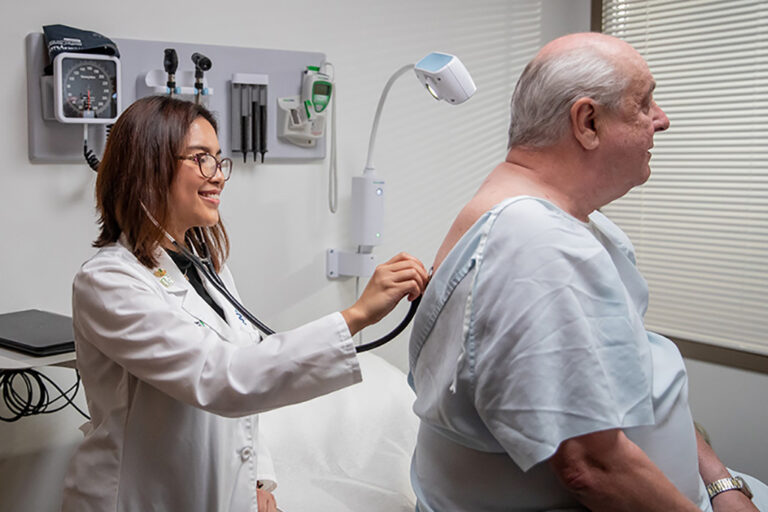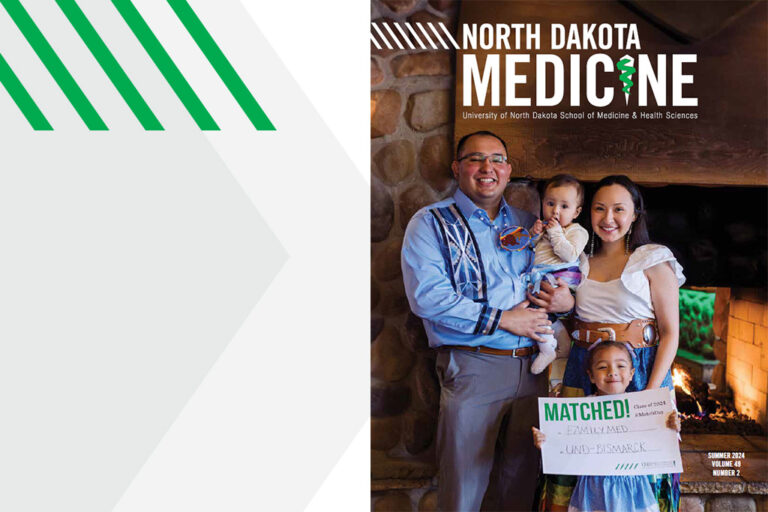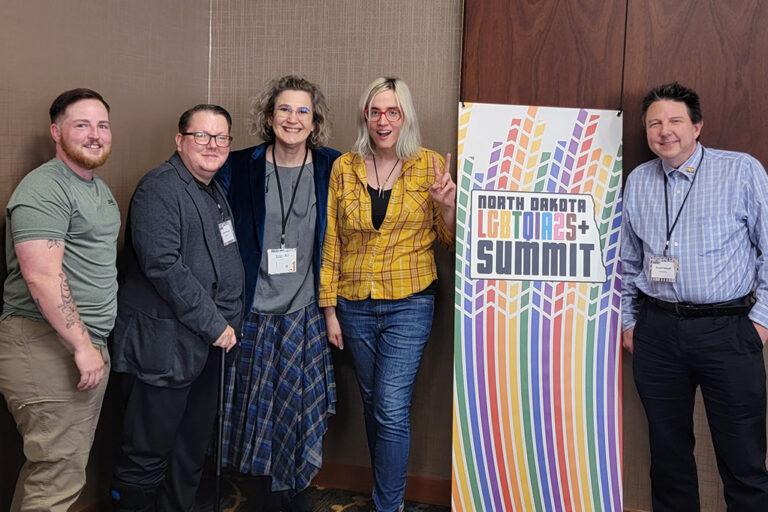Less invisible
In honor of the 75th birthday of UND’s Medical Laboratory Science (MLS) program, North Dakota Medicine is running two stories in 2024 that describe the origins and evolution of the behind-the-scenes practitioners who provide an invaluable service to hospitals, clinics, and public health programs. This second of two stories recaps the evolution of the standalone Department of Medical Laboratory Science in the twenty-first century.
To hear Ruth Paur tell it, Medical Laboratory Science (MLS) was hardly on her career radar – at least at first.
Then she spent some time with her sister in Minnesota back in the early-1980s.
“My sister was in MLS, and I sat with her for a couple of hours in the microbiology lab in Mankato,” the Gilby, N.D., resident recalled over the phone from a vacation stop in Florida. “And I said, ‘You actually get paid for having this much fun?’ I realized I really liked MLS, so I majored in that.”
What made laboratory science so much fun?
“Solving the mysteries,” Paur continued. “You have an organism growing and you had to identify what organism that was, and then figure out what antibiotic would fight that bacteria. It was a discovery process and the utilization of science, because a lot of times it can be hard to apply scientific concepts. But you really apply the science in MLS.”
Growing MLS through teaching
Degree in hand, Paur began practicing medical laboratory science in a local laboratory, learning quickly just how much she enjoyed teaching laboratory procedures and analysis to her younger colleagues.
“Those were my favorite days – teaching on the bench, when I’d have a student show up,” she added. “That’s when I realized what I really wanted to do.”
After a decade of teaching at what is today Northland Community & Technical College in East Grand Forks, Minn., Paur eventually hopped over the Red River to become Associate Director of what was by then known as the Clinical Laboratory Science program at UND.
Founded officially in 1949, the little-program-that-could was at the time housed within the UND School of Medicine & Health Sciences (SMHS) Department of Pathology. Having seen its share of financial and enrollment challenges, by the time Paur joined the program it was already on the upswing.
Helping former program director Wayne Bruce – who retired in 2003 and passed away in 2023 – expand laboratory science at UND, Paur spent countless hours helping facilitate both the program’s Western College Alliance for Medical Laboratory Science (WCAMLS), which brought students from twelve midwestern colleges and universities to UND for laboratory training. She also oversaw its original Mayo Clinic partnership, which sent UND faculty to Rochester, Minn., to teach lab professionals whose academic backgrounds were in general science rather than MLS specifically.
Explaining how her team was already coordinating distance courses via WCAMLS, Paur said that the Mayo Clinic partnership was a “natural fit” that really helped grow and diversify UND’s program.
Working her way to director after Bruce retired, Paur helped manage the program’s move to a standalone Department of Medical Laboratory Science, which happened in 2011.
In other words, by the time Paur, now a department chair, retired, UND’s once unassuming program in “medical technology” had grown up.
And grown in general. According to the national accrediting agency for Clinical Laboratory Sciences, UND MLS produces quadruple the national average of annual graduates amongst accredited MLS programs.
Today, the fully independent Department of Medical Laboratory Science not only still trains students from other colleges – and Mayo Clinic – but maintains its traditional undergraduate and master-level degrees in MLS, as well as asynchronous options for working professionals, including categorical and histotechnology programs.
“I’m proud of the stability of our partnerships,” Paur mused of the role she played in helping UND’s MLS program mature. “And all of those clinical affiliates – my goodness, there were so many. It was a lot of work.”
The new century
Reflecting on the department’s maturation, current chair Brooke Solberg, who was already a faculty member in the program when Paur retired in 2018, admits that her mentor, Paur, drew her into the profession.
“I ended up coming to UND to major in chemical engineering,” smiled Solberg from her office in the UND School of Medicine & Health Sciences building in Grand Forks. “Then I found out that calculus wasn’t my thing.”
But she loved chemistry. So, sitting on the bed in her dorm room one night that first college semester, she recalls, Solberg flipped through UND’s course catalog – then a paper document – and found herself drawn to the pages immediately after the listing for chemical engineering: clinical laboratory science.
“It sounded interesting, so that week I ended up going to Ruth’s office. By the end of the conversation, I’d decided, ‘I want to do lab science.’ I changed my major and completed this program.”
After practicing MLS in the Minneapolis-St. Paul area for a few years, the Rolla, N.D., native made her way back up to North Dakota for a role in what was then a “new” department.
Workforce challenges
Since then, it has been Solberg’s job to help raise the profile of a traditionally behind-the-scenes profession that still struggles with the ironic double bind of an “invisibility” that helps contribute to a national workforce shortage.
“I joke that my family still doesn’t know what I do,” Solberg continued, explaining how articulating the laboratorian’s job isn’t as obvious as it seems. “We’re behind the scenes, so many people assume we get their blood sample and voila – you get a test result. But it’s what happens in-between – all those steps – that really define us as medical laboratory scientists.”
Echoing Solberg, assistant professor of MLS Karen Peterson suggested that the interpretation of data points like white blood cell counts and protein deposits in urine is part of the challenge, and can vary among laboratorians and physicians.
“There’s a whole lot of critical thinking and troubleshooting taking place on a daily basis in the lab that we are doing to assure that those results are accurate,” Peterson explained. “In the public eye, laboratory testing has been simplified, because we have home tests that somebody without a degree can definitely perform. But what many people don’t recognize is just how complex laboratory testing is.”
Consider your everyday pregnancy test, said Peterson. As simple as such tests seem, there’s a glut of science behind their operations, from antibodies to color tagging to quality control.
“So it’s not just a plus or minus on the pregnancy test. You have to analyze all this biochemical information and come up with a best judgment.”
To that point, the growth in home testing that accompanied the SARS-CoV-2 pandemic helped shine a spotlight on MLS – helping it be less invisible.
“Since COVID, there are certainly more people who are aware of testing and how important lab analysis is,” Solberg mused. “I definitely think there is more awareness now, but that doesn’t automatically translate to an obvious boost in enrollment or lessening of the existing workforce shortage.”
Peterson agreed, noting that “according to the Bureau of Labor Statistics, roughly 24,000 MLS jobs will become available annually. But we only graduated 6,000 students last year as a profession. So, there’s still a big gap.”
Less invisible
This, then, is the charge for Solberg and her team: maintain – if not grow – a profession that is clamoring, if the reader will excuse the pun, for new blood.
“Health facilities want to hire, but they’re having a hard time,” Solberg said. “We’re getting contacted almost constantly. Employers tell us: ‘Your grads – send them our way.’ So, we definitely see the need for more MLS professionals.”
To help boost not only the profession’s visibility but its workforce for the next 75 years, Solberg’s team is hard at work revising its curriculum and trying to be less behind-the-scenes by getting in front of more potential students and community partners. Part of that latter effort includes expanding interprofessional efforts within the SMHS, sending faculty and students out to participate in community events such as career fairs or blood drives, and creating new program options to reach even more learners throughout the state and region.
It’s all a bit of a test, Solberg concluded. And if it’s anything like the last 75 years, she expects the results will be positive.


